Analysis of Financial Resource Management in the Hospitality Sector
VerifiedAdded on 2023/06/18
|9
|2483
|89
Report
AI Summary
This report delves into the crucial topic of financial resource management within the hospitality industry, emphasizing its significance in controlling and monitoring financial aspects to enhance profitability. It begins by outlining Generally Accepted Accounting Principles (GAAP) and their role in standardizing financial reporting, followed by an identification of the various users of financial statements, such as company management, investors, and lenders, and their respective decision-making needs. The report then examines the financial statements of interest to different stakeholders, including loan and trade creditors. It further discusses the components of an annual report, including the balance sheet, income statement, cash flow statement, changes in equity, and notes to the financial statements, alongside a discussion of financial reporting concepts. The core of the report involves an evaluation of Smart Resort Ltd.'s performance, utilizing financial ratio analysis to assess the company's profitability, liquidity, and efficiency over a two-year period, providing insights into its strengths and areas for improvement. The analysis includes detailed calculations of various financial ratios such as net profit margin, ROA, ROE, current ratio, quick ratio, and debt-to-equity ratio, followed by a comprehensive interpretation of the results. The report concludes with a summary of the key findings, highlighting Smart Resort's overall financial health and providing recommendations for future financial management strategies.

Managing financial
resources in
Hospitality industry
resources in
Hospitality industry
Paraphrase This Document
Need a fresh take? Get an instant paraphrase of this document with our AI Paraphraser
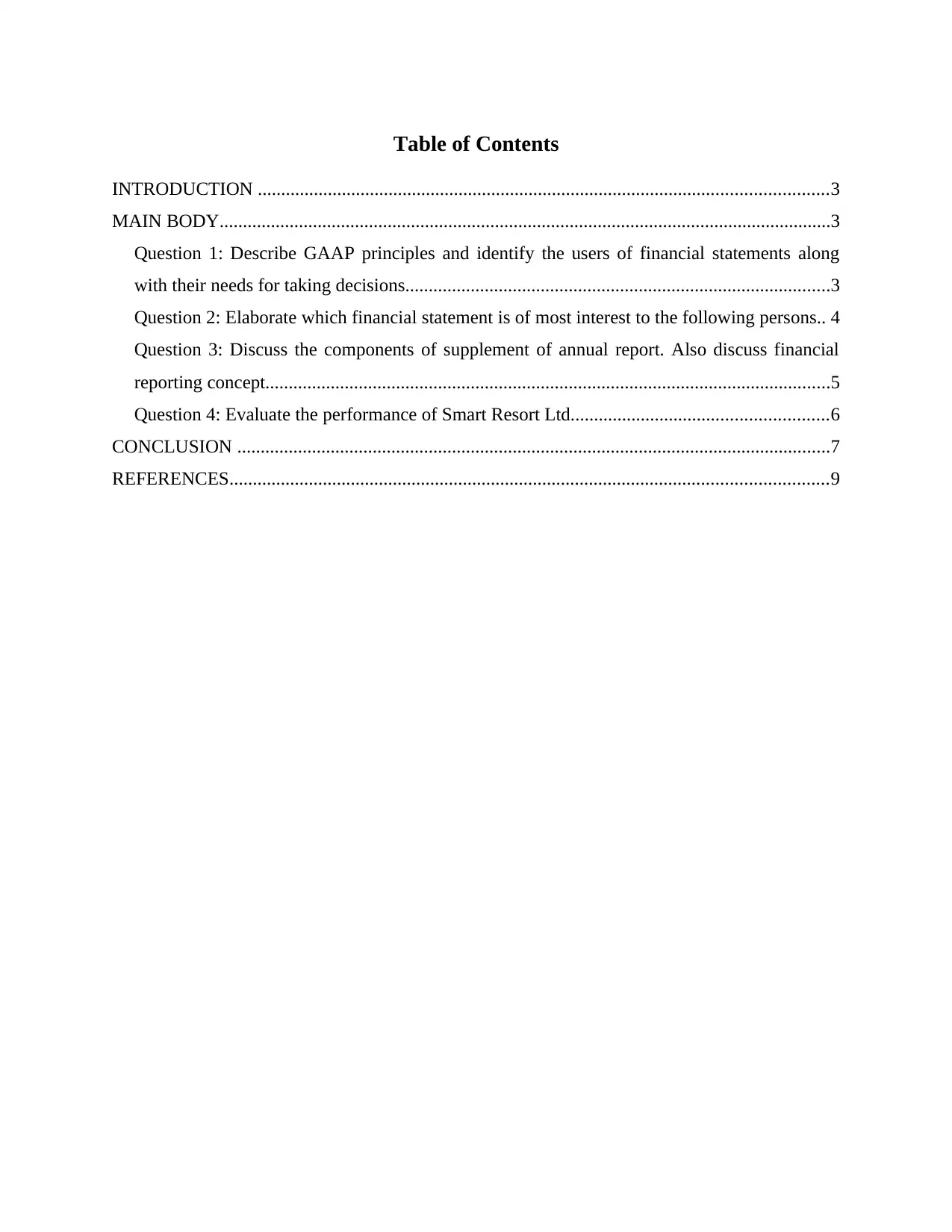
Table of Contents
INTRODUCTION ..........................................................................................................................3
MAIN BODY...................................................................................................................................3
Question 1: Describe GAAP principles and identify the users of financial statements along
with their needs for taking decisions...........................................................................................3
Question 2: Elaborate which financial statement is of most interest to the following persons.. 4
Question 3: Discuss the components of supplement of annual report. Also discuss financial
reporting concept.........................................................................................................................5
Question 4: Evaluate the performance of Smart Resort Ltd.......................................................6
CONCLUSION ...............................................................................................................................7
REFERENCES................................................................................................................................9
INTRODUCTION ..........................................................................................................................3
MAIN BODY...................................................................................................................................3
Question 1: Describe GAAP principles and identify the users of financial statements along
with their needs for taking decisions...........................................................................................3
Question 2: Elaborate which financial statement is of most interest to the following persons.. 4
Question 3: Discuss the components of supplement of annual report. Also discuss financial
reporting concept.........................................................................................................................5
Question 4: Evaluate the performance of Smart Resort Ltd.......................................................6
CONCLUSION ...............................................................................................................................7
REFERENCES................................................................................................................................9
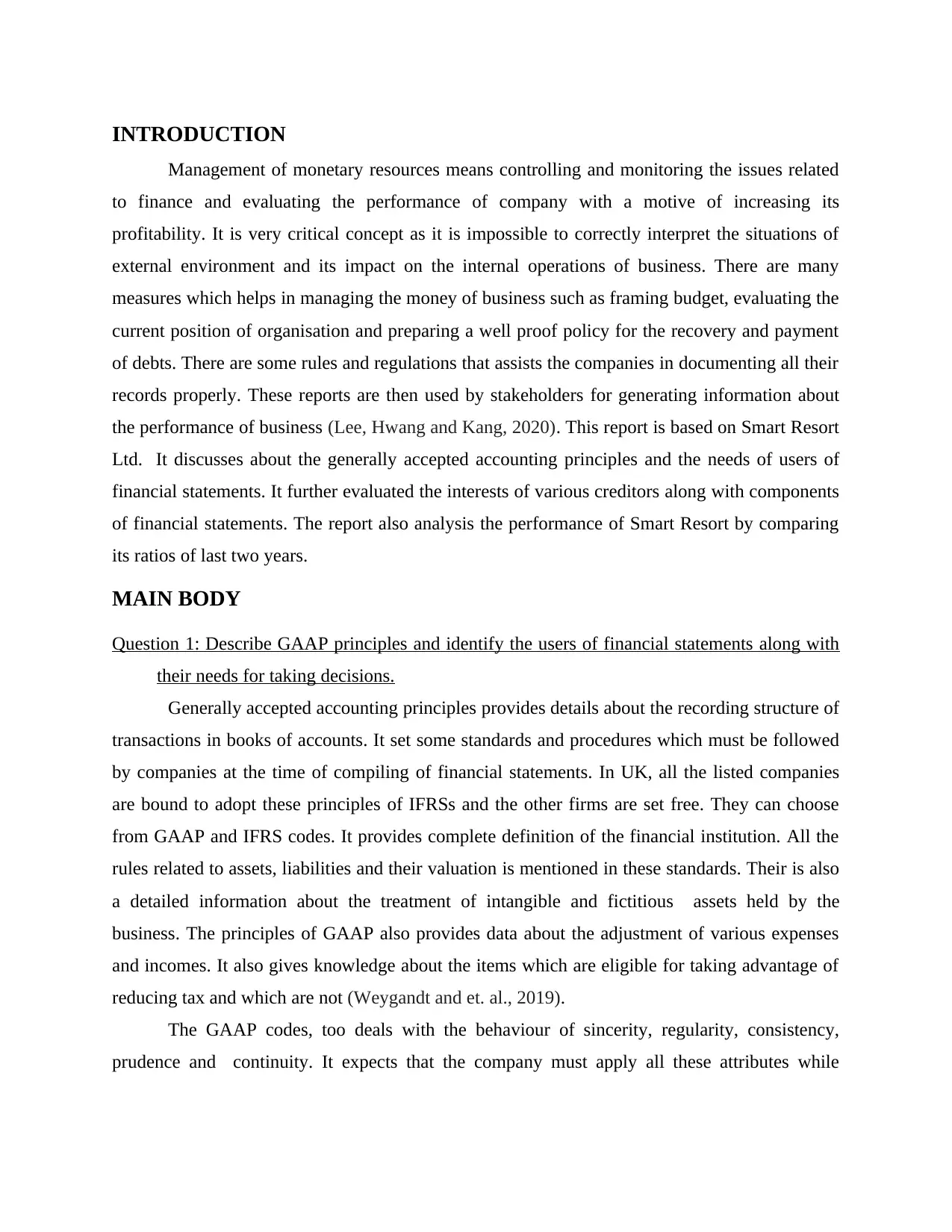
INTRODUCTION
Management of monetary resources means controlling and monitoring the issues related
to finance and evaluating the performance of company with a motive of increasing its
profitability. It is very critical concept as it is impossible to correctly interpret the situations of
external environment and its impact on the internal operations of business. There are many
measures which helps in managing the money of business such as framing budget, evaluating the
current position of organisation and preparing a well proof policy for the recovery and payment
of debts. There are some rules and regulations that assists the companies in documenting all their
records properly. These reports are then used by stakeholders for generating information about
the performance of business (Lee, Hwang and Kang, 2020). This report is based on Smart Resort
Ltd. It discusses about the generally accepted accounting principles and the needs of users of
financial statements. It further evaluated the interests of various creditors along with components
of financial statements. The report also analysis the performance of Smart Resort by comparing
its ratios of last two years.
MAIN BODY
Question 1: Describe GAAP principles and identify the users of financial statements along with
their needs for taking decisions.
Generally accepted accounting principles provides details about the recording structure of
transactions in books of accounts. It set some standards and procedures which must be followed
by companies at the time of compiling of financial statements. In UK, all the listed companies
are bound to adopt these principles of IFRSs and the other firms are set free. They can choose
from GAAP and IFRS codes. It provides complete definition of the financial institution. All the
rules related to assets, liabilities and their valuation is mentioned in these standards. Their is also
a detailed information about the treatment of intangible and fictitious assets held by the
business. The principles of GAAP also provides data about the adjustment of various expenses
and incomes. It also gives knowledge about the items which are eligible for taking advantage of
reducing tax and which are not (Weygandt and et. al., 2019).
The GAAP codes, too deals with the behaviour of sincerity, regularity, consistency,
prudence and continuity. It expects that the company must apply all these attributes while
Management of monetary resources means controlling and monitoring the issues related
to finance and evaluating the performance of company with a motive of increasing its
profitability. It is very critical concept as it is impossible to correctly interpret the situations of
external environment and its impact on the internal operations of business. There are many
measures which helps in managing the money of business such as framing budget, evaluating the
current position of organisation and preparing a well proof policy for the recovery and payment
of debts. There are some rules and regulations that assists the companies in documenting all their
records properly. These reports are then used by stakeholders for generating information about
the performance of business (Lee, Hwang and Kang, 2020). This report is based on Smart Resort
Ltd. It discusses about the generally accepted accounting principles and the needs of users of
financial statements. It further evaluated the interests of various creditors along with components
of financial statements. The report also analysis the performance of Smart Resort by comparing
its ratios of last two years.
MAIN BODY
Question 1: Describe GAAP principles and identify the users of financial statements along with
their needs for taking decisions.
Generally accepted accounting principles provides details about the recording structure of
transactions in books of accounts. It set some standards and procedures which must be followed
by companies at the time of compiling of financial statements. In UK, all the listed companies
are bound to adopt these principles of IFRSs and the other firms are set free. They can choose
from GAAP and IFRS codes. It provides complete definition of the financial institution. All the
rules related to assets, liabilities and their valuation is mentioned in these standards. Their is also
a detailed information about the treatment of intangible and fictitious assets held by the
business. The principles of GAAP also provides data about the adjustment of various expenses
and incomes. It also gives knowledge about the items which are eligible for taking advantage of
reducing tax and which are not (Weygandt and et. al., 2019).
The GAAP codes, too deals with the behaviour of sincerity, regularity, consistency,
prudence and continuity. It expects that the company must apply all these attributes while
⊘ This is a preview!⊘
Do you want full access?
Subscribe today to unlock all pages.

Trusted by 1+ million students worldwide
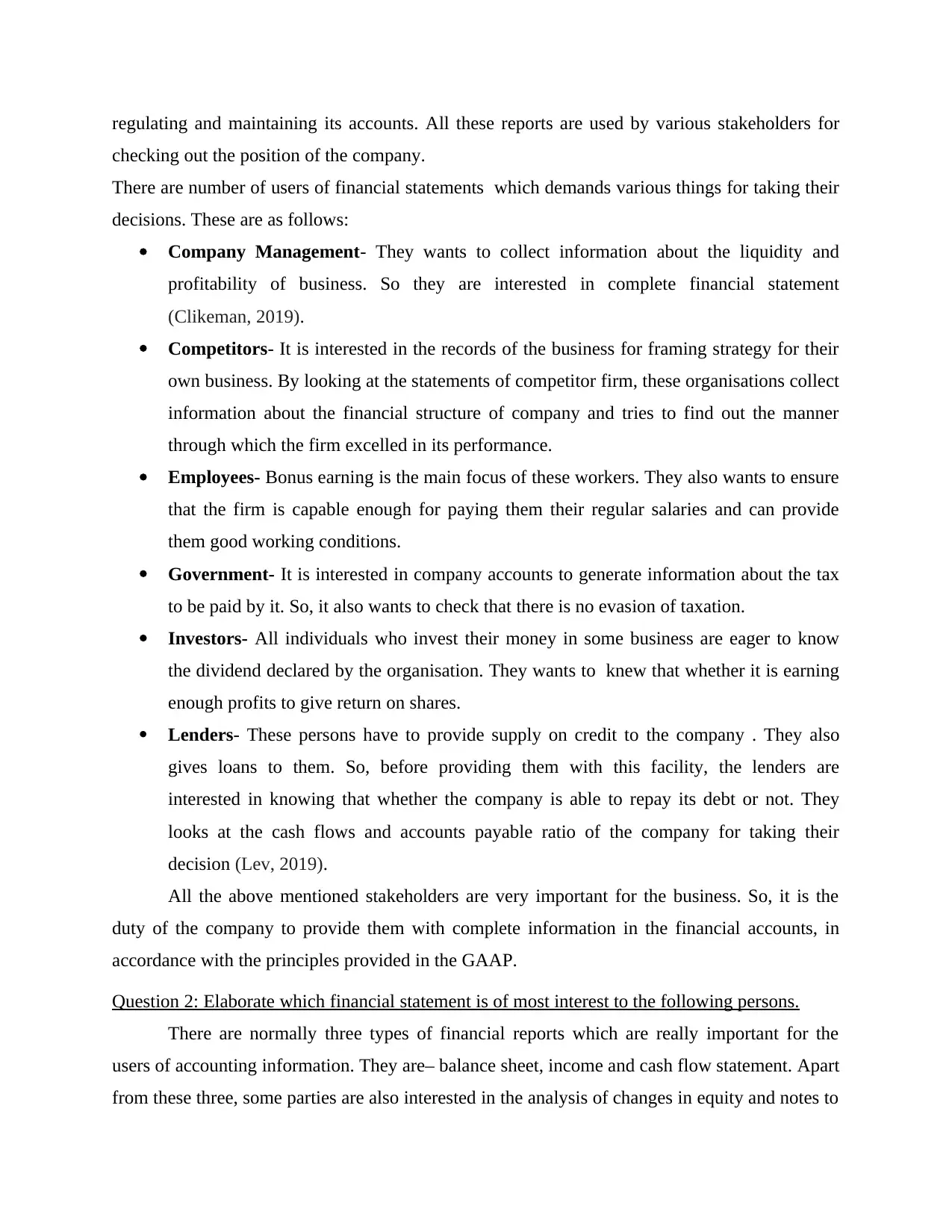
regulating and maintaining its accounts. All these reports are used by various stakeholders for
checking out the position of the company.
There are number of users of financial statements which demands various things for taking their
decisions. These are as follows:
Company Management- They wants to collect information about the liquidity and
profitability of business. So they are interested in complete financial statement
(Clikeman, 2019).
Competitors- It is interested in the records of the business for framing strategy for their
own business. By looking at the statements of competitor firm, these organisations collect
information about the financial structure of company and tries to find out the manner
through which the firm excelled in its performance.
Employees- Bonus earning is the main focus of these workers. They also wants to ensure
that the firm is capable enough for paying them their regular salaries and can provide
them good working conditions.
Government- It is interested in company accounts to generate information about the tax
to be paid by it. So, it also wants to check that there is no evasion of taxation.
Investors- All individuals who invest their money in some business are eager to know
the dividend declared by the organisation. They wants to knew that whether it is earning
enough profits to give return on shares.
Lenders- These persons have to provide supply on credit to the company . They also
gives loans to them. So, before providing them with this facility, the lenders are
interested in knowing that whether the company is able to repay its debt or not. They
looks at the cash flows and accounts payable ratio of the company for taking their
decision (Lev, 2019).
All the above mentioned stakeholders are very important for the business. So, it is the
duty of the company to provide them with complete information in the financial accounts, in
accordance with the principles provided in the GAAP.
Question 2: Elaborate which financial statement is of most interest to the following persons.
There are normally three types of financial reports which are really important for the
users of accounting information. They are– balance sheet, income and cash flow statement. Apart
from these three, some parties are also interested in the analysis of changes in equity and notes to
checking out the position of the company.
There are number of users of financial statements which demands various things for taking their
decisions. These are as follows:
Company Management- They wants to collect information about the liquidity and
profitability of business. So they are interested in complete financial statement
(Clikeman, 2019).
Competitors- It is interested in the records of the business for framing strategy for their
own business. By looking at the statements of competitor firm, these organisations collect
information about the financial structure of company and tries to find out the manner
through which the firm excelled in its performance.
Employees- Bonus earning is the main focus of these workers. They also wants to ensure
that the firm is capable enough for paying them their regular salaries and can provide
them good working conditions.
Government- It is interested in company accounts to generate information about the tax
to be paid by it. So, it also wants to check that there is no evasion of taxation.
Investors- All individuals who invest their money in some business are eager to know
the dividend declared by the organisation. They wants to knew that whether it is earning
enough profits to give return on shares.
Lenders- These persons have to provide supply on credit to the company . They also
gives loans to them. So, before providing them with this facility, the lenders are
interested in knowing that whether the company is able to repay its debt or not. They
looks at the cash flows and accounts payable ratio of the company for taking their
decision (Lev, 2019).
All the above mentioned stakeholders are very important for the business. So, it is the
duty of the company to provide them with complete information in the financial accounts, in
accordance with the principles provided in the GAAP.
Question 2: Elaborate which financial statement is of most interest to the following persons.
There are normally three types of financial reports which are really important for the
users of accounting information. They are– balance sheet, income and cash flow statement. Apart
from these three, some parties are also interested in the analysis of changes in equity and notes to
Paraphrase This Document
Need a fresh take? Get an instant paraphrase of this document with our AI Paraphraser
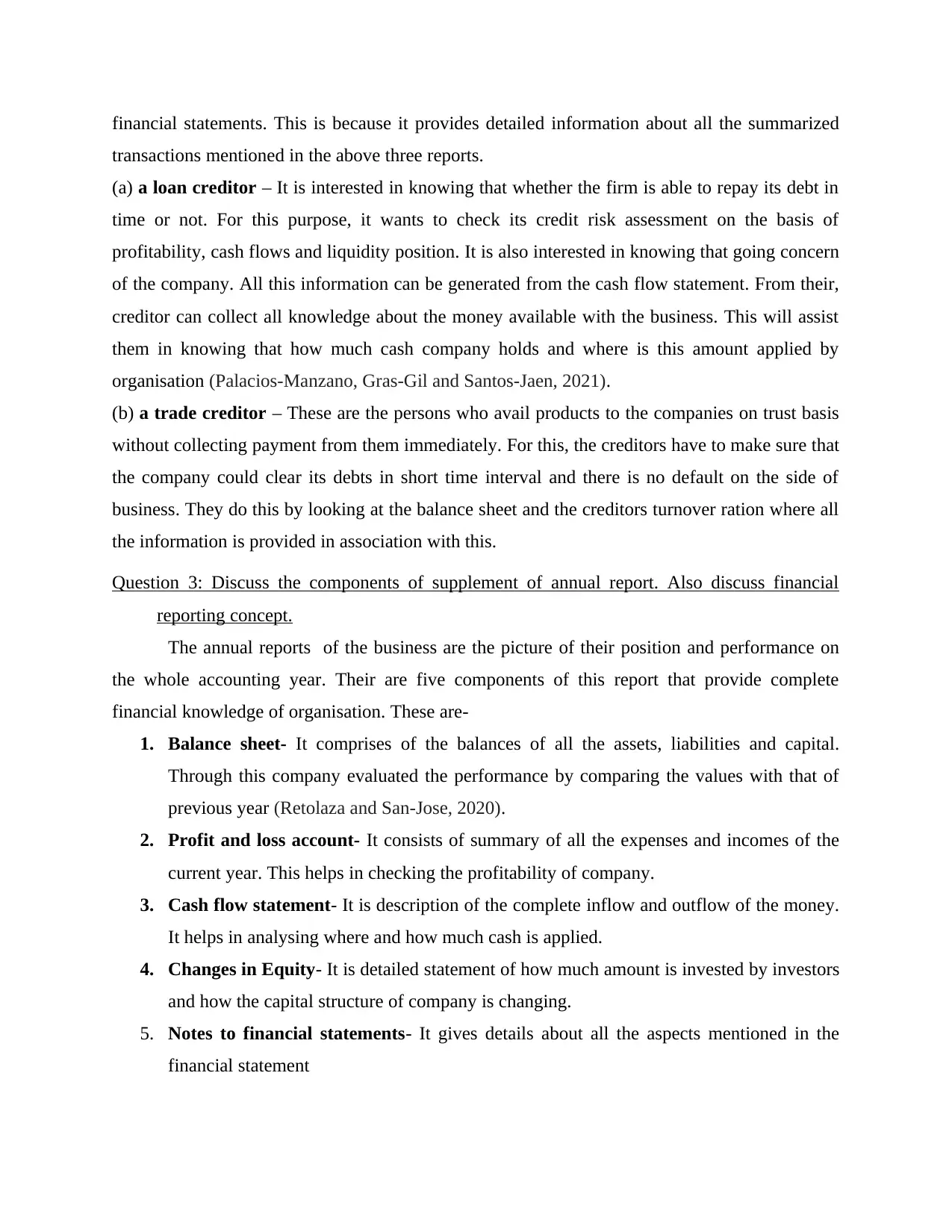
financial statements. This is because it provides detailed information about all the summarized
transactions mentioned in the above three reports.
(a) a loan creditor – It is interested in knowing that whether the firm is able to repay its debt in
time or not. For this purpose, it wants to check its credit risk assessment on the basis of
profitability, cash flows and liquidity position. It is also interested in knowing that going concern
of the company. All this information can be generated from the cash flow statement. From their,
creditor can collect all knowledge about the money available with the business. This will assist
them in knowing that how much cash company holds and where is this amount applied by
organisation (Palacios-Manzano, Gras-Gil and Santos-Jaen, 2021).
(b) a trade creditor – These are the persons who avail products to the companies on trust basis
without collecting payment from them immediately. For this, the creditors have to make sure that
the company could clear its debts in short time interval and there is no default on the side of
business. They do this by looking at the balance sheet and the creditors turnover ration where all
the information is provided in association with this.
Question 3: Discuss the components of supplement of annual report. Also discuss financial
reporting concept.
The annual reports of the business are the picture of their position and performance on
the whole accounting year. Their are five components of this report that provide complete
financial knowledge of organisation. These are-
1. Balance sheet- It comprises of the balances of all the assets, liabilities and capital.
Through this company evaluated the performance by comparing the values with that of
previous year (Retolaza and San-Jose, 2020).
2. Profit and loss account- It consists of summary of all the expenses and incomes of the
current year. This helps in checking the profitability of company.
3. Cash flow statement- It is description of the complete inflow and outflow of the money.
It helps in analysing where and how much cash is applied.
4. Changes in Equity- It is detailed statement of how much amount is invested by investors
and how the capital structure of company is changing.
5. Notes to financial statements- It gives details about all the aspects mentioned in the
financial statement
transactions mentioned in the above three reports.
(a) a loan creditor – It is interested in knowing that whether the firm is able to repay its debt in
time or not. For this purpose, it wants to check its credit risk assessment on the basis of
profitability, cash flows and liquidity position. It is also interested in knowing that going concern
of the company. All this information can be generated from the cash flow statement. From their,
creditor can collect all knowledge about the money available with the business. This will assist
them in knowing that how much cash company holds and where is this amount applied by
organisation (Palacios-Manzano, Gras-Gil and Santos-Jaen, 2021).
(b) a trade creditor – These are the persons who avail products to the companies on trust basis
without collecting payment from them immediately. For this, the creditors have to make sure that
the company could clear its debts in short time interval and there is no default on the side of
business. They do this by looking at the balance sheet and the creditors turnover ration where all
the information is provided in association with this.
Question 3: Discuss the components of supplement of annual report. Also discuss financial
reporting concept.
The annual reports of the business are the picture of their position and performance on
the whole accounting year. Their are five components of this report that provide complete
financial knowledge of organisation. These are-
1. Balance sheet- It comprises of the balances of all the assets, liabilities and capital.
Through this company evaluated the performance by comparing the values with that of
previous year (Retolaza and San-Jose, 2020).
2. Profit and loss account- It consists of summary of all the expenses and incomes of the
current year. This helps in checking the profitability of company.
3. Cash flow statement- It is description of the complete inflow and outflow of the money.
It helps in analysing where and how much cash is applied.
4. Changes in Equity- It is detailed statement of how much amount is invested by investors
and how the capital structure of company is changing.
5. Notes to financial statements- It gives details about all the aspects mentioned in the
financial statement
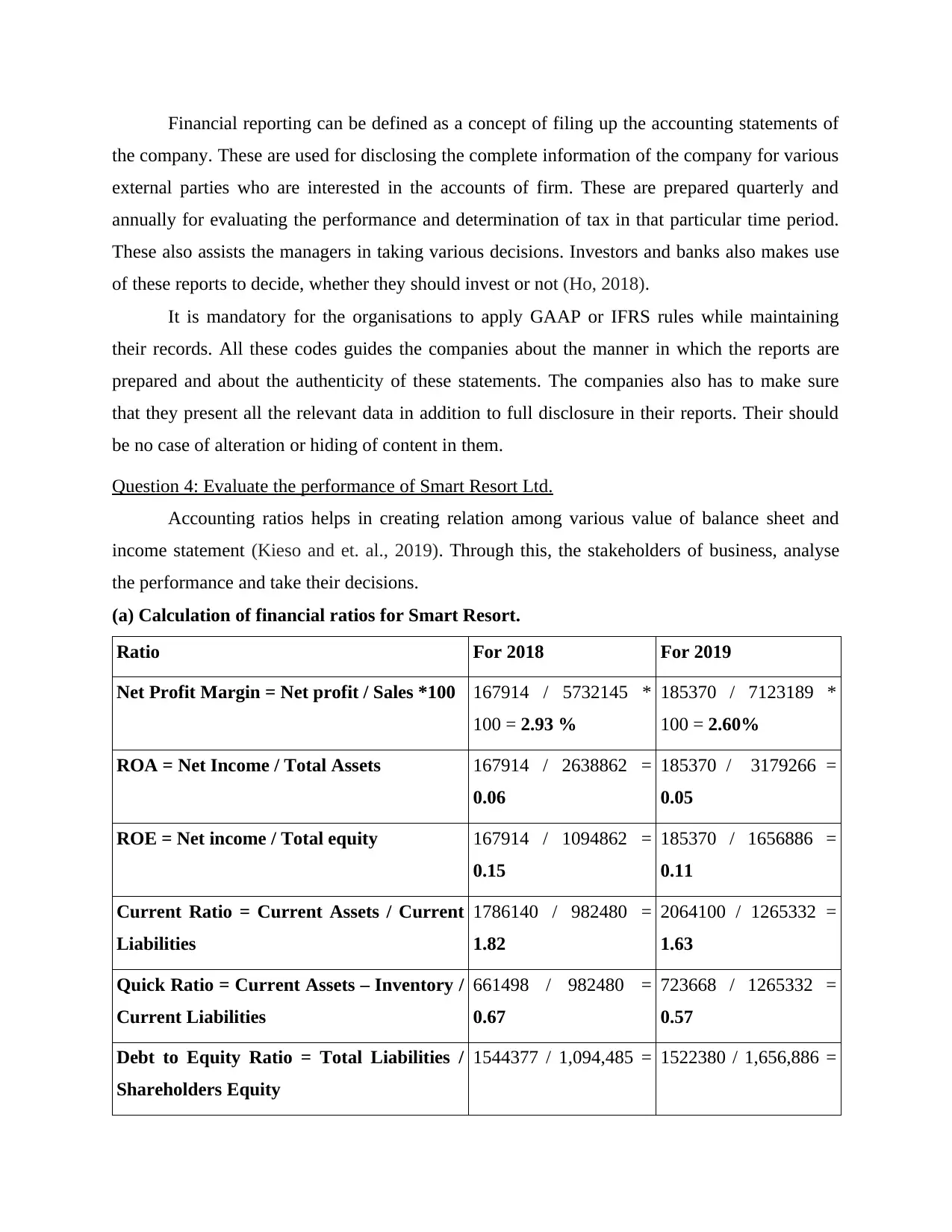
Financial reporting can be defined as a concept of filing up the accounting statements of
the company. These are used for disclosing the complete information of the company for various
external parties who are interested in the accounts of firm. These are prepared quarterly and
annually for evaluating the performance and determination of tax in that particular time period.
These also assists the managers in taking various decisions. Investors and banks also makes use
of these reports to decide, whether they should invest or not (Ho, 2018).
It is mandatory for the organisations to apply GAAP or IFRS rules while maintaining
their records. All these codes guides the companies about the manner in which the reports are
prepared and about the authenticity of these statements. The companies also has to make sure
that they present all the relevant data in addition to full disclosure in their reports. Their should
be no case of alteration or hiding of content in them.
Question 4: Evaluate the performance of Smart Resort Ltd.
Accounting ratios helps in creating relation among various value of balance sheet and
income statement (Kieso and et. al., 2019). Through this, the stakeholders of business, analyse
the performance and take their decisions.
(a) Calculation of financial ratios for Smart Resort.
Ratio For 2018 For 2019
Net Profit Margin = Net profit / Sales *100 167914 / 5732145 *
100 = 2.93 %
185370 / 7123189 *
100 = 2.60%
ROA = Net Income / Total Assets 167914 / 2638862 =
0.06
185370 / 3179266 =
0.05
ROE = Net income / Total equity 167914 / 1094862 =
0.15
185370 / 1656886 =
0.11
Current Ratio = Current Assets / Current
Liabilities
1786140 / 982480 =
1.82
2064100 / 1265332 =
1.63
Quick Ratio = Current Assets – Inventory /
Current Liabilities
661498 / 982480 =
0.67
723668 / 1265332 =
0.57
Debt to Equity Ratio = Total Liabilities /
Shareholders Equity
1544377 / 1,094,485 = 1522380 / 1,656,886 =
the company. These are used for disclosing the complete information of the company for various
external parties who are interested in the accounts of firm. These are prepared quarterly and
annually for evaluating the performance and determination of tax in that particular time period.
These also assists the managers in taking various decisions. Investors and banks also makes use
of these reports to decide, whether they should invest or not (Ho, 2018).
It is mandatory for the organisations to apply GAAP or IFRS rules while maintaining
their records. All these codes guides the companies about the manner in which the reports are
prepared and about the authenticity of these statements. The companies also has to make sure
that they present all the relevant data in addition to full disclosure in their reports. Their should
be no case of alteration or hiding of content in them.
Question 4: Evaluate the performance of Smart Resort Ltd.
Accounting ratios helps in creating relation among various value of balance sheet and
income statement (Kieso and et. al., 2019). Through this, the stakeholders of business, analyse
the performance and take their decisions.
(a) Calculation of financial ratios for Smart Resort.
Ratio For 2018 For 2019
Net Profit Margin = Net profit / Sales *100 167914 / 5732145 *
100 = 2.93 %
185370 / 7123189 *
100 = 2.60%
ROA = Net Income / Total Assets 167914 / 2638862 =
0.06
185370 / 3179266 =
0.05
ROE = Net income / Total equity 167914 / 1094862 =
0.15
185370 / 1656886 =
0.11
Current Ratio = Current Assets / Current
Liabilities
1786140 / 982480 =
1.82
2064100 / 1265332 =
1.63
Quick Ratio = Current Assets – Inventory /
Current Liabilities
661498 / 982480 =
0.67
723668 / 1265332 =
0.57
Debt to Equity Ratio = Total Liabilities /
Shareholders Equity
1544377 / 1,094,485 = 1522380 / 1,656,886 =
⊘ This is a preview!⊘
Do you want full access?
Subscribe today to unlock all pages.

Trusted by 1+ million students worldwide
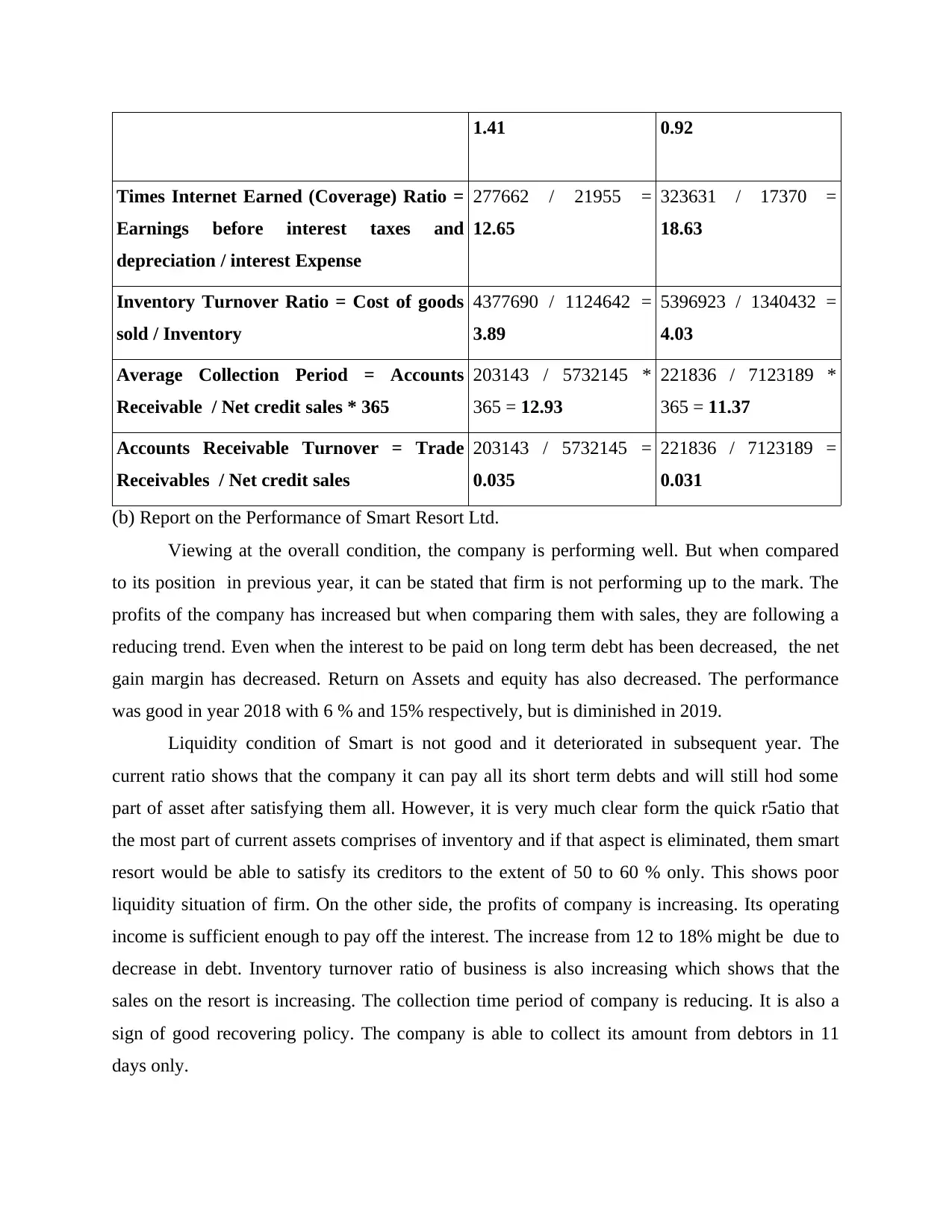
1.41 0.92
Times Internet Earned (Coverage) Ratio =
Earnings before interest taxes and
depreciation / interest Expense
277662 / 21955 =
12.65
323631 / 17370 =
18.63
Inventory Turnover Ratio = Cost of goods
sold / Inventory
4377690 / 1124642 =
3.89
5396923 / 1340432 =
4.03
Average Collection Period = Accounts
Receivable / Net credit sales * 365
203143 / 5732145 *
365 = 12.93
221836 / 7123189 *
365 = 11.37
Accounts Receivable Turnover = Trade
Receivables / Net credit sales
203143 / 5732145 =
0.035
221836 / 7123189 =
0.031
(b) Report on the Performance of Smart Resort Ltd.
Viewing at the overall condition, the company is performing well. But when compared
to its position in previous year, it can be stated that firm is not performing up to the mark. The
profits of the company has increased but when comparing them with sales, they are following a
reducing trend. Even when the interest to be paid on long term debt has been decreased, the net
gain margin has decreased. Return on Assets and equity has also decreased. The performance
was good in year 2018 with 6 % and 15% respectively, but is diminished in 2019.
Liquidity condition of Smart is not good and it deteriorated in subsequent year. The
current ratio shows that the company it can pay all its short term debts and will still hod some
part of asset after satisfying them all. However, it is very much clear form the quick r5atio that
the most part of current assets comprises of inventory and if that aspect is eliminated, them smart
resort would be able to satisfy its creditors to the extent of 50 to 60 % only. This shows poor
liquidity situation of firm. On the other side, the profits of company is increasing. Its operating
income is sufficient enough to pay off the interest. The increase from 12 to 18% might be due to
decrease in debt. Inventory turnover ratio of business is also increasing which shows that the
sales on the resort is increasing. The collection time period of company is reducing. It is also a
sign of good recovering policy. The company is able to collect its amount from debtors in 11
days only.
Times Internet Earned (Coverage) Ratio =
Earnings before interest taxes and
depreciation / interest Expense
277662 / 21955 =
12.65
323631 / 17370 =
18.63
Inventory Turnover Ratio = Cost of goods
sold / Inventory
4377690 / 1124642 =
3.89
5396923 / 1340432 =
4.03
Average Collection Period = Accounts
Receivable / Net credit sales * 365
203143 / 5732145 *
365 = 12.93
221836 / 7123189 *
365 = 11.37
Accounts Receivable Turnover = Trade
Receivables / Net credit sales
203143 / 5732145 =
0.035
221836 / 7123189 =
0.031
(b) Report on the Performance of Smart Resort Ltd.
Viewing at the overall condition, the company is performing well. But when compared
to its position in previous year, it can be stated that firm is not performing up to the mark. The
profits of the company has increased but when comparing them with sales, they are following a
reducing trend. Even when the interest to be paid on long term debt has been decreased, the net
gain margin has decreased. Return on Assets and equity has also decreased. The performance
was good in year 2018 with 6 % and 15% respectively, but is diminished in 2019.
Liquidity condition of Smart is not good and it deteriorated in subsequent year. The
current ratio shows that the company it can pay all its short term debts and will still hod some
part of asset after satisfying them all. However, it is very much clear form the quick r5atio that
the most part of current assets comprises of inventory and if that aspect is eliminated, them smart
resort would be able to satisfy its creditors to the extent of 50 to 60 % only. This shows poor
liquidity situation of firm. On the other side, the profits of company is increasing. Its operating
income is sufficient enough to pay off the interest. The increase from 12 to 18% might be due to
decrease in debt. Inventory turnover ratio of business is also increasing which shows that the
sales on the resort is increasing. The collection time period of company is reducing. It is also a
sign of good recovering policy. The company is able to collect its amount from debtors in 11
days only.
Paraphrase This Document
Need a fresh take? Get an instant paraphrase of this document with our AI Paraphraser
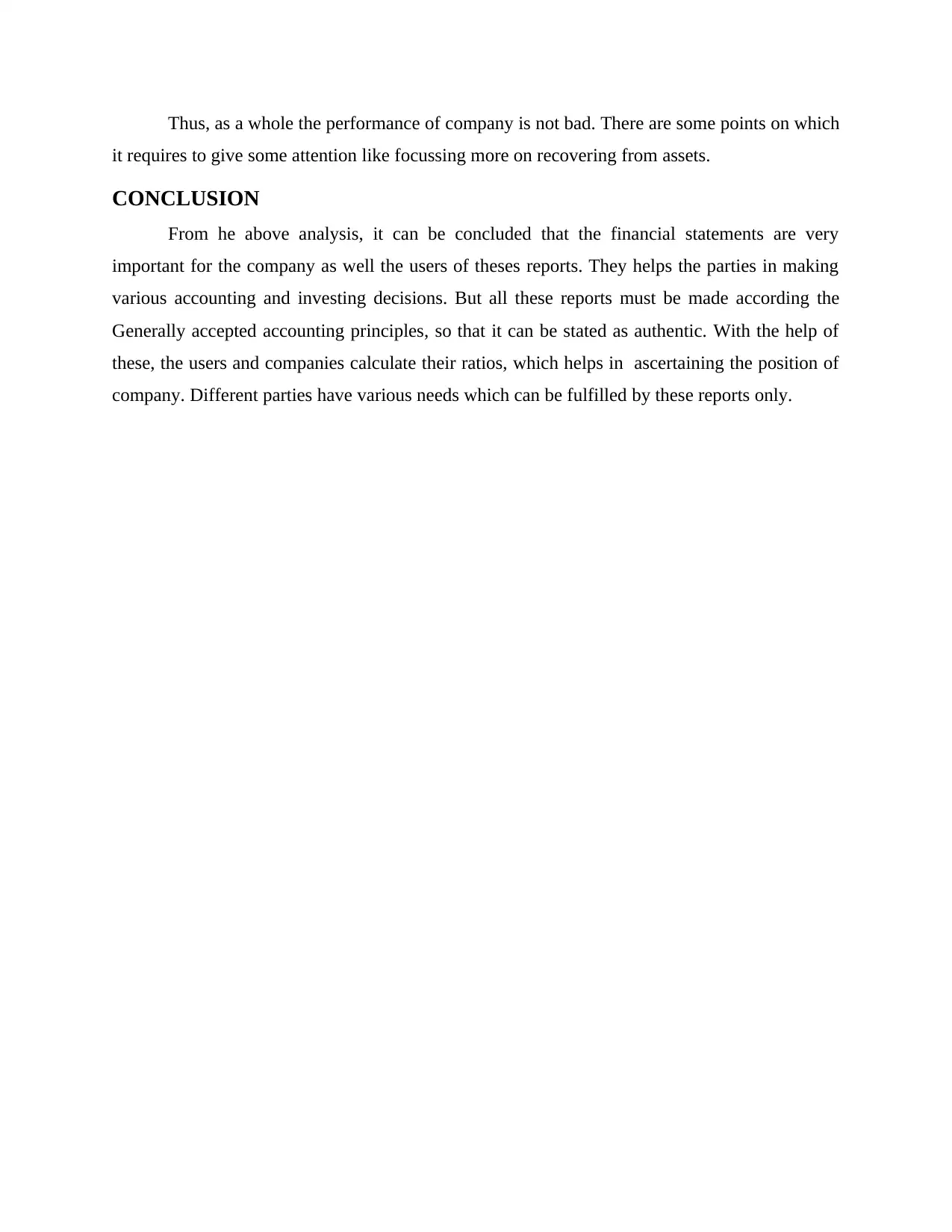
Thus, as a whole the performance of company is not bad. There are some points on which
it requires to give some attention like focussing more on recovering from assets.
CONCLUSION
From he above analysis, it can be concluded that the financial statements are very
important for the company as well the users of theses reports. They helps the parties in making
various accounting and investing decisions. But all these reports must be made according the
Generally accepted accounting principles, so that it can be stated as authentic. With the help of
these, the users and companies calculate their ratios, which helps in ascertaining the position of
company. Different parties have various needs which can be fulfilled by these reports only.
it requires to give some attention like focussing more on recovering from assets.
CONCLUSION
From he above analysis, it can be concluded that the financial statements are very
important for the company as well the users of theses reports. They helps the parties in making
various accounting and investing decisions. But all these reports must be made according the
Generally accepted accounting principles, so that it can be stated as authentic. With the help of
these, the users and companies calculate their ratios, which helps in ascertaining the position of
company. Different parties have various needs which can be fulfilled by these reports only.
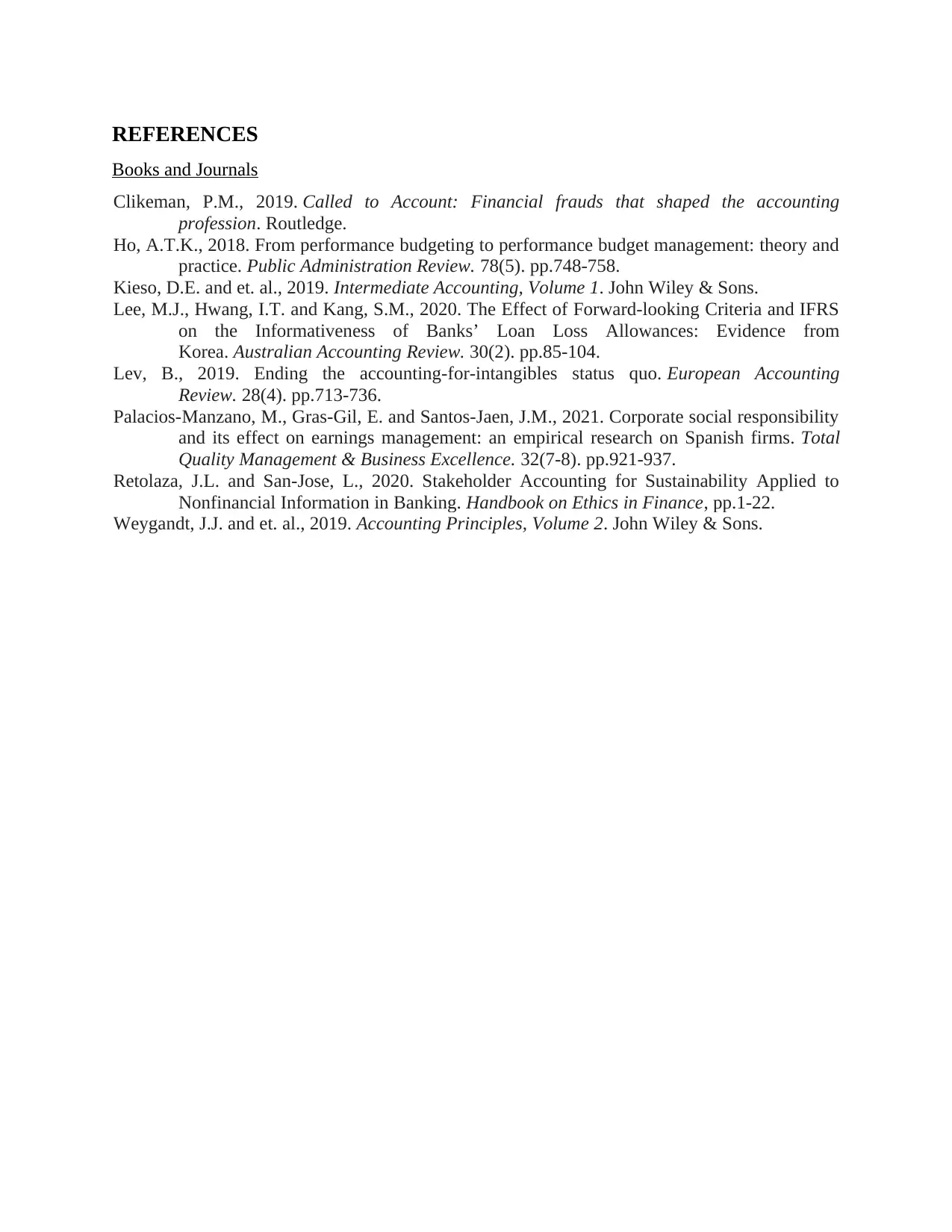
REFERENCES
Books and Journals
Clikeman, P.M., 2019. Called to Account: Financial frauds that shaped the accounting
profession. Routledge.
Ho, A.T.K., 2018. From performance budgeting to performance budget management: theory and
practice. Public Administration Review. 78(5). pp.748-758.
Kieso, D.E. and et. al., 2019. Intermediate Accounting, Volume 1. John Wiley & Sons.
Lee, M.J., Hwang, I.T. and Kang, S.M., 2020. The Effect of Forward‐looking Criteria and IFRS
on the Informativeness of Banks’ Loan Loss Allowances: Evidence from
Korea. Australian Accounting Review. 30(2). pp.85-104.
Lev, B., 2019. Ending the accounting-for-intangibles status quo. European Accounting
Review. 28(4). pp.713-736.
Palacios-Manzano, M., Gras-Gil, E. and Santos-Jaen, J.M., 2021. Corporate social responsibility
and its effect on earnings management: an empirical research on Spanish firms. Total
Quality Management & Business Excellence. 32(7-8). pp.921-937.
Retolaza, J.L. and San-Jose, L., 2020. Stakeholder Accounting for Sustainability Applied to
Nonfinancial Information in Banking. Handbook on Ethics in Finance, pp.1-22.
Weygandt, J.J. and et. al., 2019. Accounting Principles, Volume 2. John Wiley & Sons.
Books and Journals
Clikeman, P.M., 2019. Called to Account: Financial frauds that shaped the accounting
profession. Routledge.
Ho, A.T.K., 2018. From performance budgeting to performance budget management: theory and
practice. Public Administration Review. 78(5). pp.748-758.
Kieso, D.E. and et. al., 2019. Intermediate Accounting, Volume 1. John Wiley & Sons.
Lee, M.J., Hwang, I.T. and Kang, S.M., 2020. The Effect of Forward‐looking Criteria and IFRS
on the Informativeness of Banks’ Loan Loss Allowances: Evidence from
Korea. Australian Accounting Review. 30(2). pp.85-104.
Lev, B., 2019. Ending the accounting-for-intangibles status quo. European Accounting
Review. 28(4). pp.713-736.
Palacios-Manzano, M., Gras-Gil, E. and Santos-Jaen, J.M., 2021. Corporate social responsibility
and its effect on earnings management: an empirical research on Spanish firms. Total
Quality Management & Business Excellence. 32(7-8). pp.921-937.
Retolaza, J.L. and San-Jose, L., 2020. Stakeholder Accounting for Sustainability Applied to
Nonfinancial Information in Banking. Handbook on Ethics in Finance, pp.1-22.
Weygandt, J.J. and et. al., 2019. Accounting Principles, Volume 2. John Wiley & Sons.
⊘ This is a preview!⊘
Do you want full access?
Subscribe today to unlock all pages.

Trusted by 1+ million students worldwide
1 out of 9
Related Documents
Your All-in-One AI-Powered Toolkit for Academic Success.
+13062052269
info@desklib.com
Available 24*7 on WhatsApp / Email
![[object Object]](/_next/static/media/star-bottom.7253800d.svg)
Unlock your academic potential
Copyright © 2020–2025 A2Z Services. All Rights Reserved. Developed and managed by ZUCOL.

